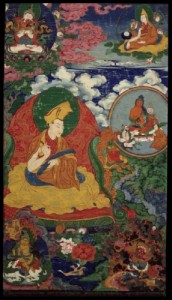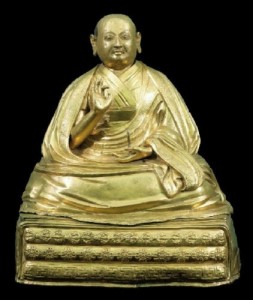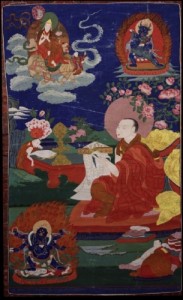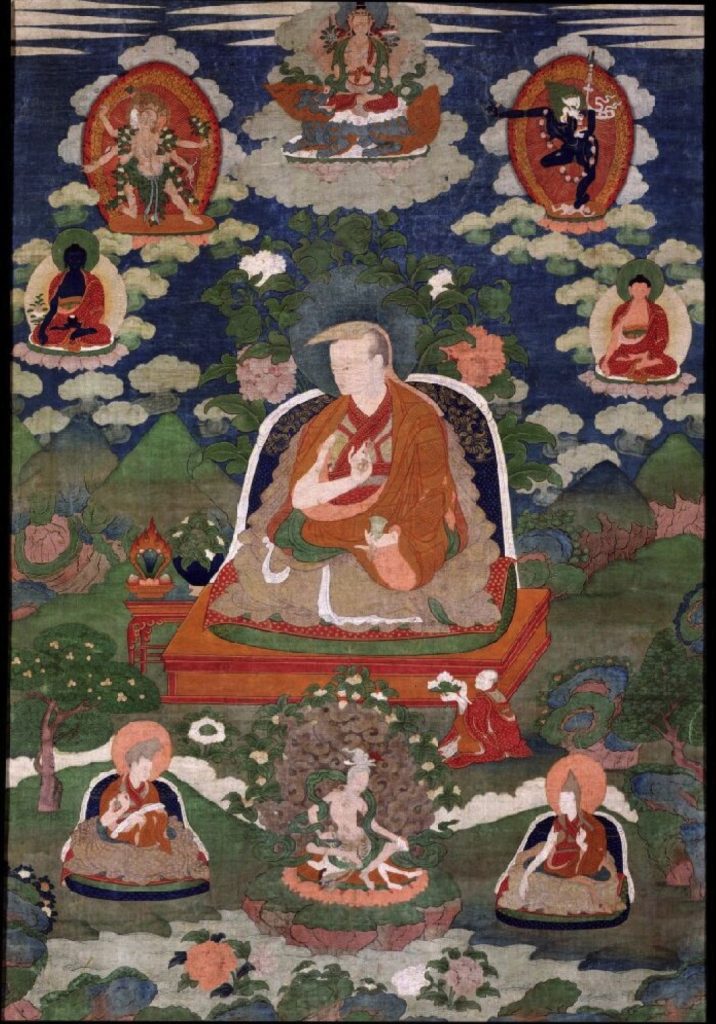An incarnation line, or line of tulku, is not established until the reincarnation of a previous lama is identified and trained. This might seem obvious, but it is worth considering that no one ever considered himself or herself the First; a tulku is always a reincarnation of someone else. By posthumously identifying an individual as an incarnate lama, his or her life story is given new dimensions and significance, and history is reshaped. This was the case with the prominent Panchen Lama incarnation line, which was created in 17th century when the Fifth Dalai Lama, Lobzang Gyatso (1617–1682), gave his teacher Lobzang Chokyi Gyeltsen (1570–1662) the title of Panchen Lama. The Great Fifth declared that his teacher was the Fourth Panchen, and the three previous lamas were henceforth considered previous incarnations.

Lobzang Chokyi Gyeltsen was born in Tsang during the second half of the 16th century. He lived during a time of tremendous political and religious change in Tibet. As a youth he became a disciple of his great uncle Sanggye Yeshe (1525-1590/91), a prominent teacher and lineage holder of the Ganden oral tradition based at Wensa Monastery. Chokyi Gyeltsen later studied at Tashilhunpo and Ganden monasteries, and in 1601 he assumed the abbacy of Tashilhunpo, which thus became the seat of all subsequent Panchen Lamas.
Soon after taking the seat at Tashilhunpo in Shigatse, Tsang, Chokyi Gyeltsen was visited by the Fourth Dalai Lama, Yonten Gyatso (1589-1616), a Mongolian child who was identified by Mongolian patrons as the
reincarnation of the previous Dalai Lama, Sonam Gyatso (1543-1588), the first Dalai Lama to hold the title. Chokyi Gyeltsen was influential in the Tibetan reception of Yonten Gyatso as a legitimate reincarnation of the Third Dalai Lama, an act that surely gave him political clout among the Mongolian powers that backed the emerging Geluk tradition.
In 1618, after the death of the Fourth Dalai Lama, Chokyi Gyeltsen was able to secure permission from the new king of Tsang to confirm the next Dalai Lama, Lobzang Gyatso. Chokyi Gyeltsen was well placed to negotiate between the rival Kagyu rulers based in Tsang and the growing Geluk power based in Lhasa. As the Fifth Dalai Lama’s influence and power grew, so did Chokyi Gyeltsen’s, and in 1641 he was awarded the title of Fourth Panchen Lama.* Three previous lamas were posthumously given the Panchen Lama title as well: Khedrubje Gelek Pelzang (1385-1438), Sonam Chokyi Langpo (1439-1504), and Wensapa Lobzang Dondrub (1505-1556).

The next man posthumously identified as a Panchen Lama was Sonam Chokyi Langpo, who was born into a poor family in Tsang. At a young age he was taken to the Fifth Ganden Tripa, Lodro Chokyong, who gave him his ordination name. He was then admitted into Ganden monastery where he engaged in intense studies of Buddhist scripture. Returning to Tsang, he is thought to have commissioned a metal statue of the Buddha and is given credit for founding a small monastery named Uding.

The Panchen Lama line of incarnates has continued on to the present day with the Eleventh Panchen. The identification of the current Panchen Lama incarnation, as is well known, has been an international tragedy. The Fourteenth Dalai Lama identified a boy named Gendun Chokyi Nyima as the Eleventh Panchen Lama in 1995. Chinese authorities, however, identified a different incarnate—Gyeltsen Norbu—and in 1995 placed Gendun Chokyi Nyima under house arrest. His location is still unknown.
*Given that Lobzang Chokyi Gyeltsen was the first man to hold the title of Panchen Lama, an alternate enumeration system has him as the First Panchen, with the previous three being simply prior incarnations.
Biography and autobiography in Tibet are important sources for both education and inspiration. Tibetans have kept such meticulous records of their teachers that thousands of names are known and discussed in a wide range of biographical material. All these names, all these lives—it can be a little overwhelming. The authors involved in the Treasury of Lives are currently mining the primary sources to provide English-language biographies of every known religious teacher from Tibet and the Himalaya, all of which are organized for easy searching and browsing.
Thank you for subscribing to Tricycle! As a nonprofit, we depend on readers like you to keep Buddhist teachings and practices widely available.
